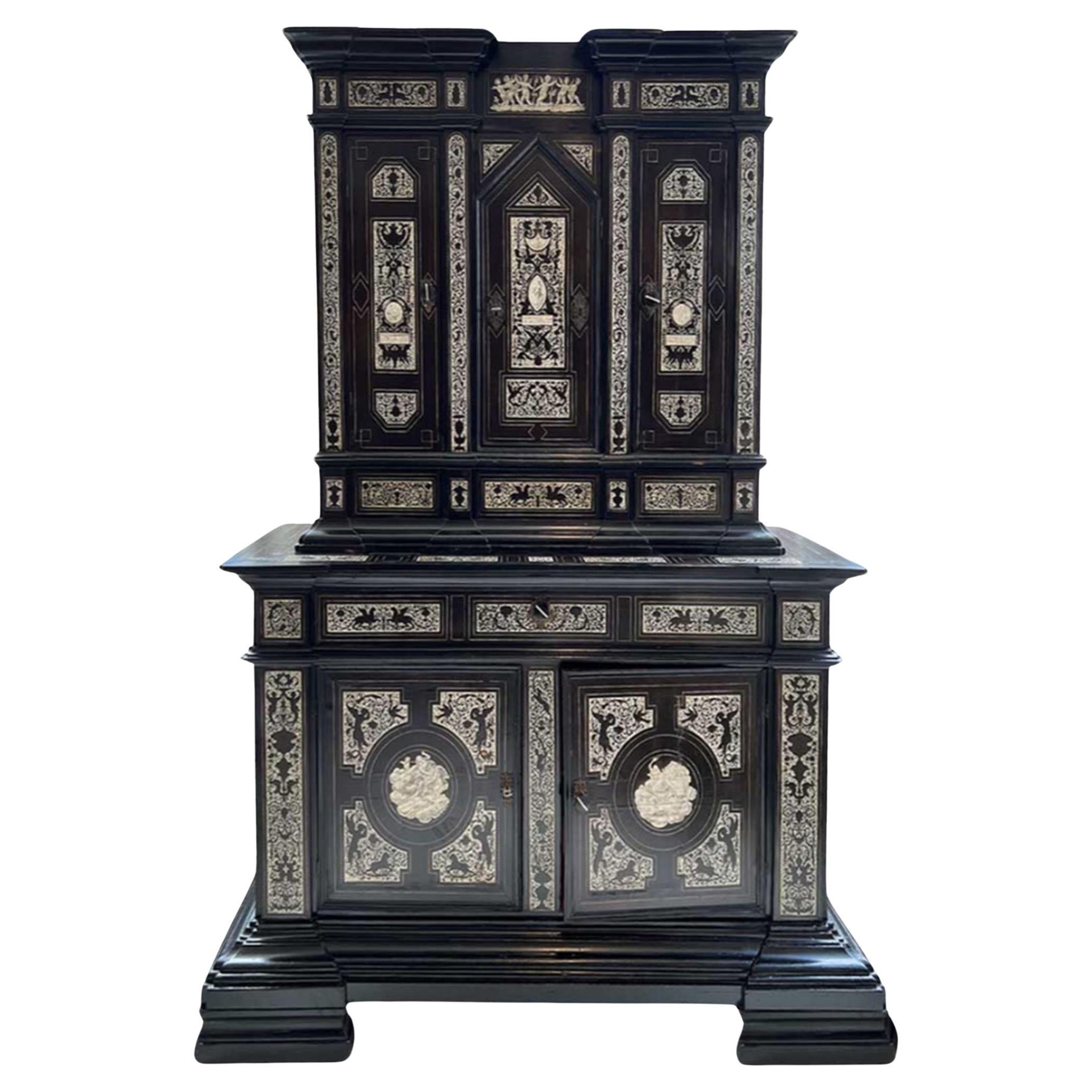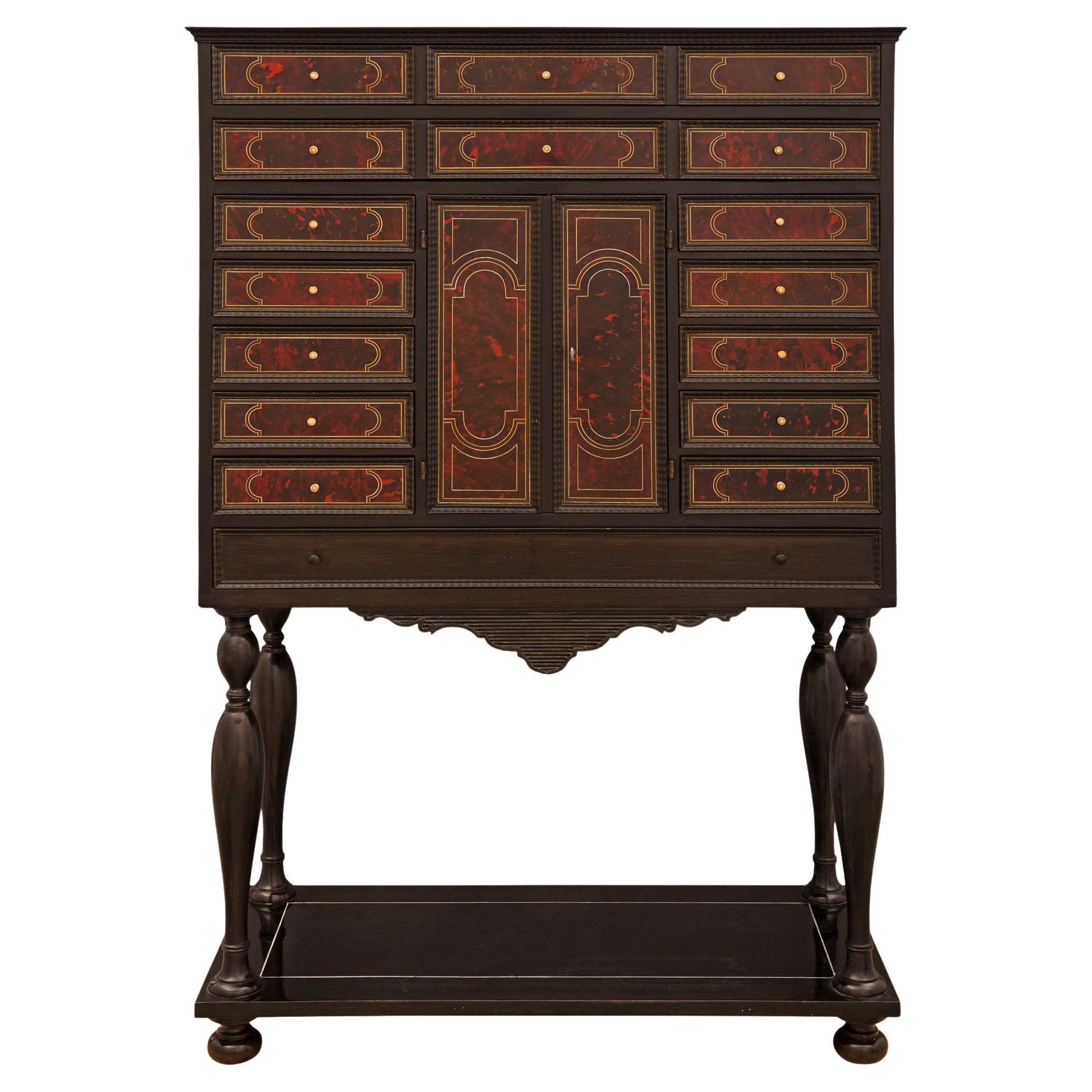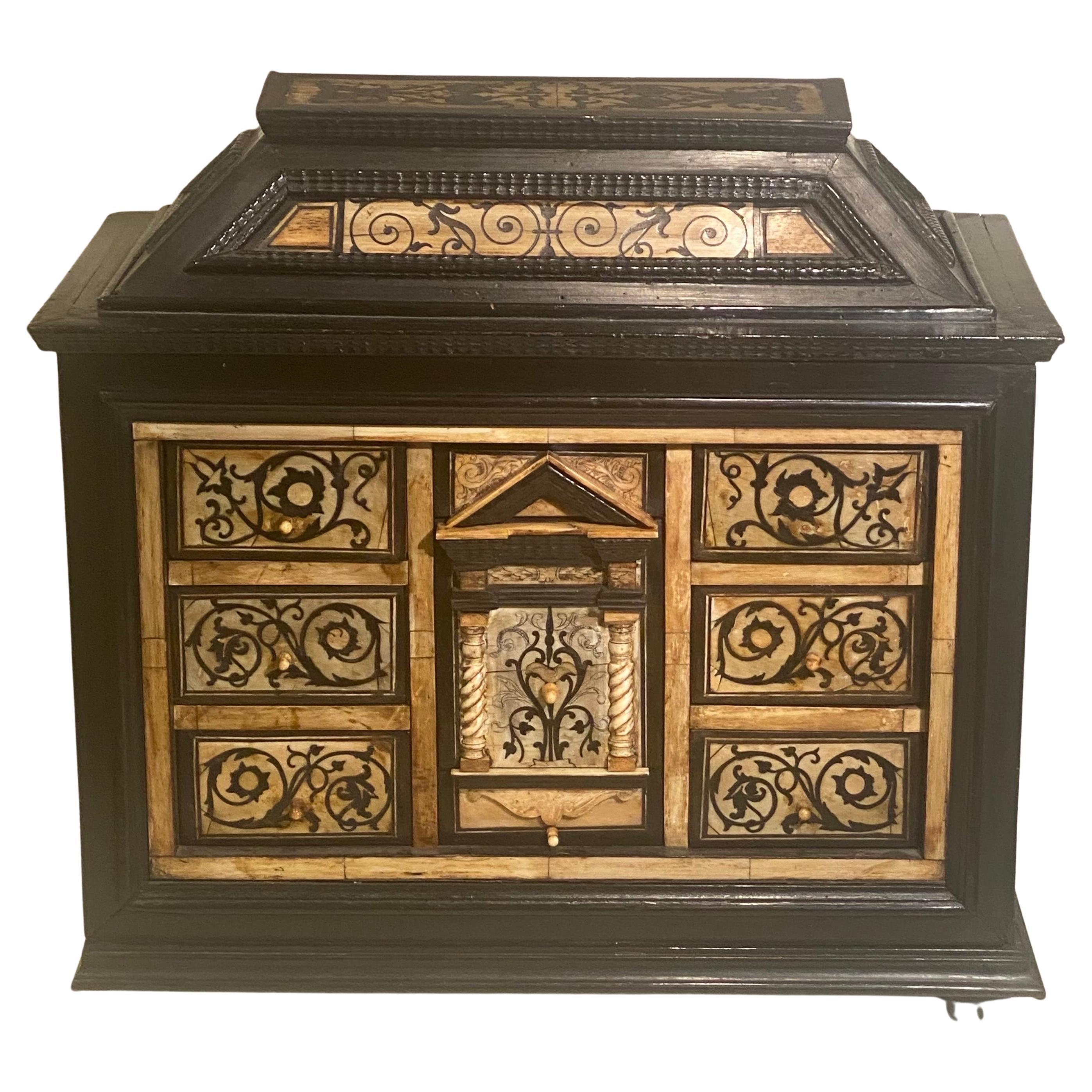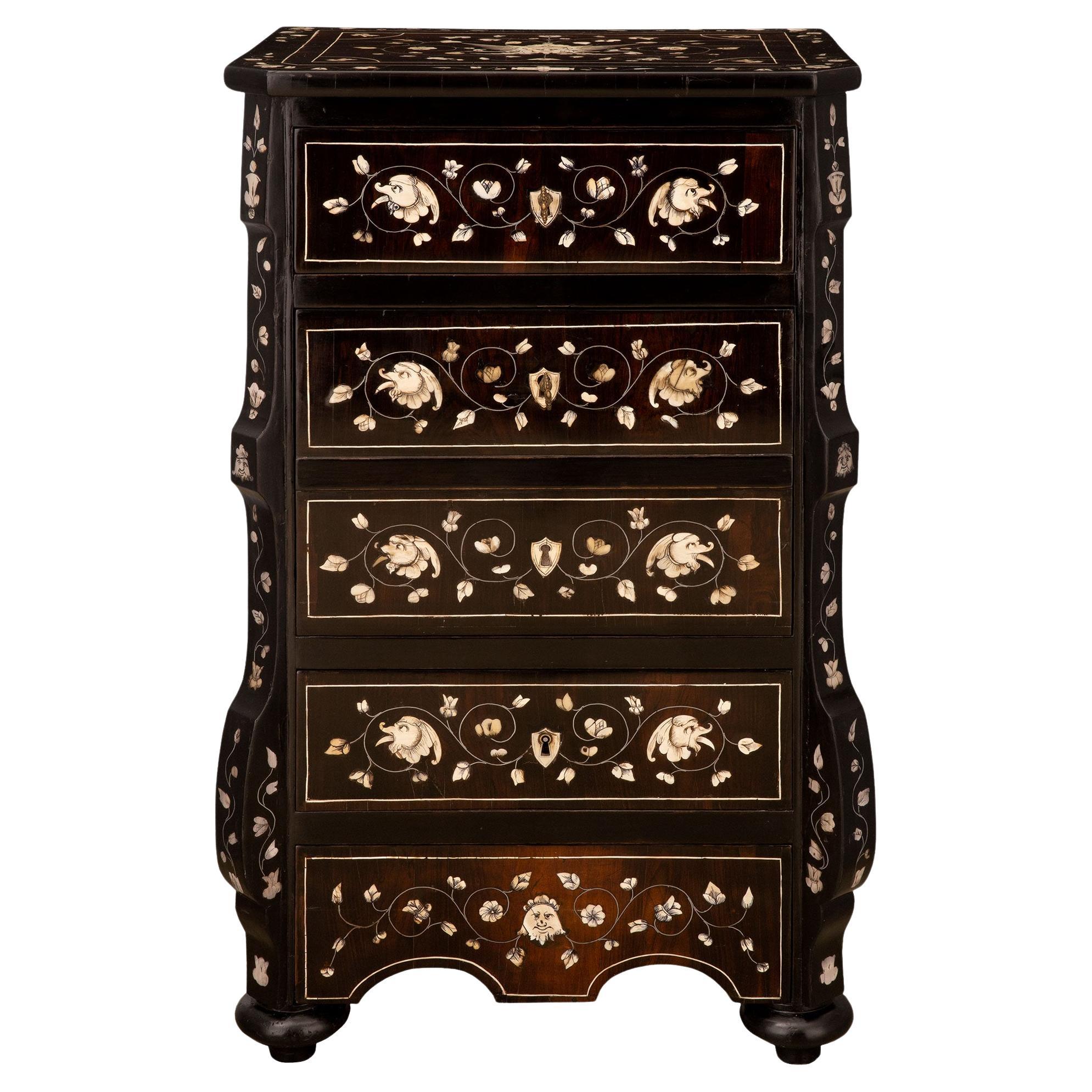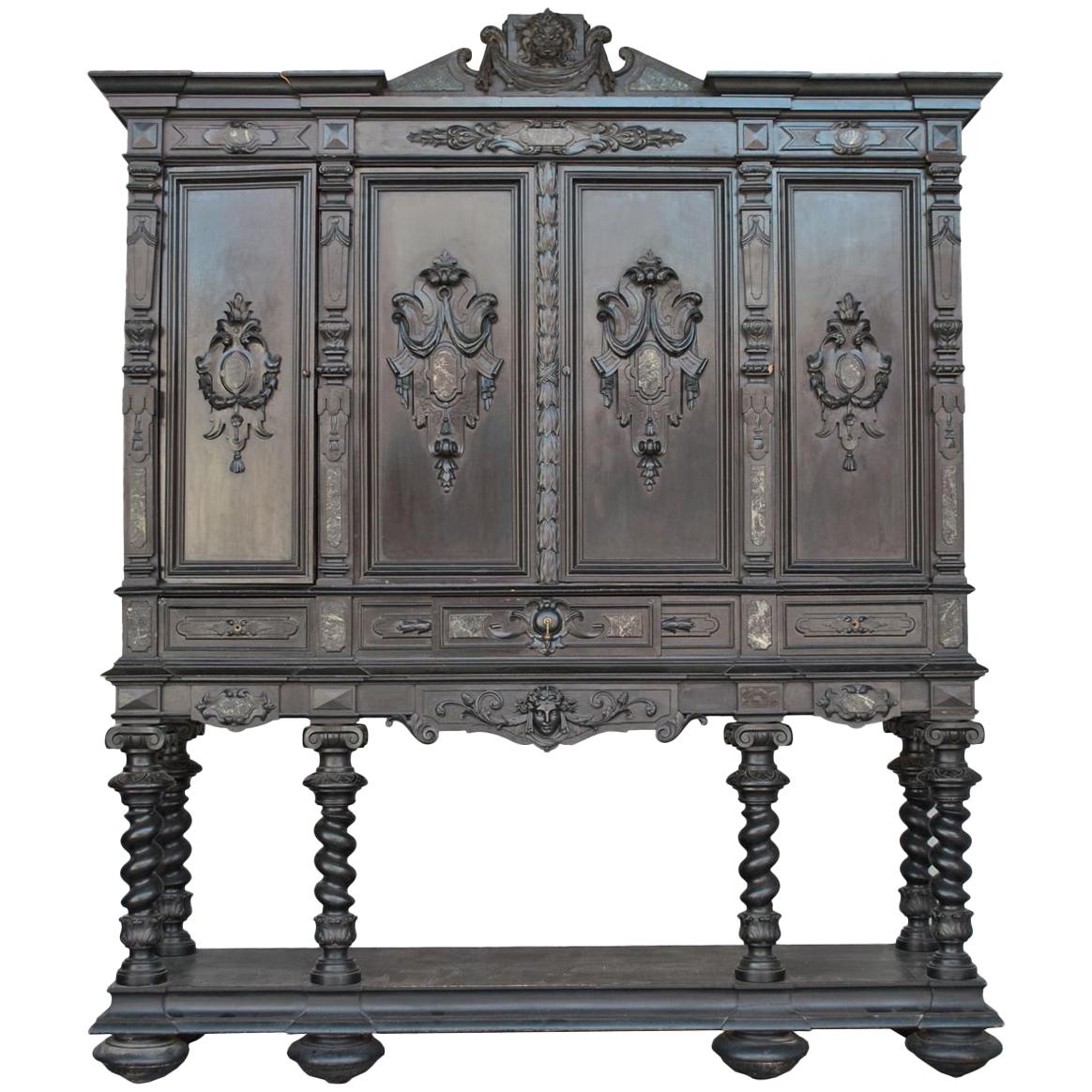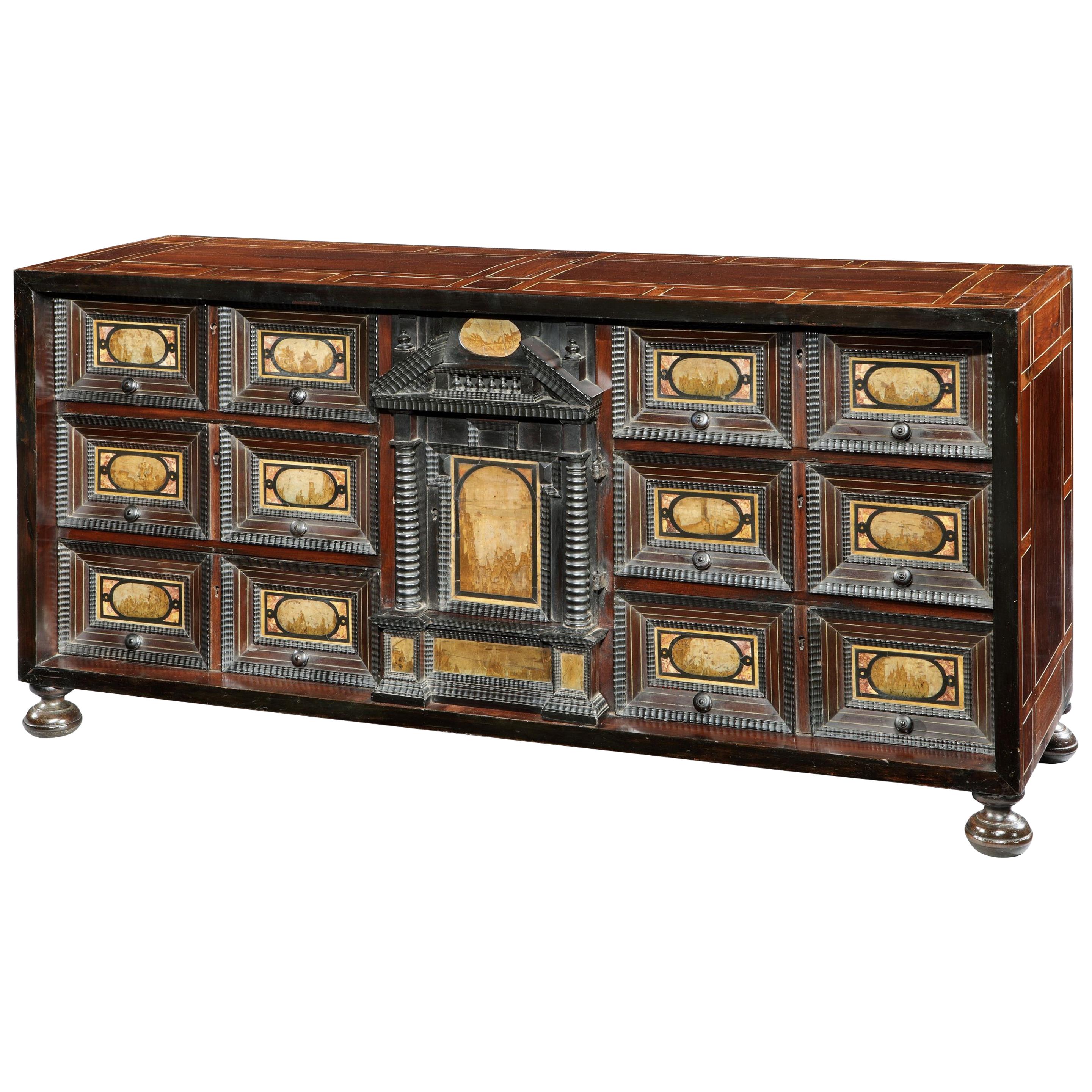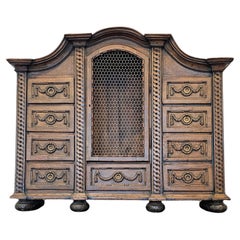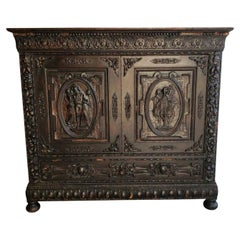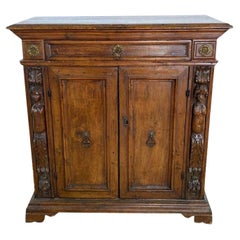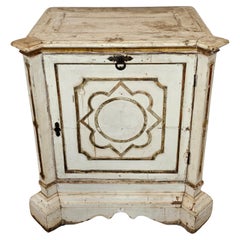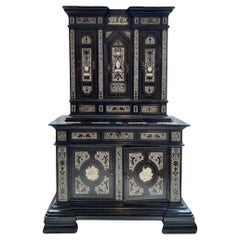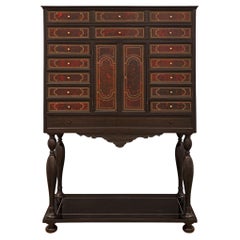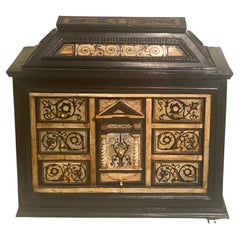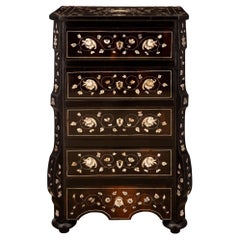Objekte ähnlich wie 17th Century Italian Milano Renaissance Period Bone Ivory Ebony Tabletop Cabinet
Möchten Sie mehr Bilder oder Videos?
Zusätzliche Bilder oder Videos von dem*der Anbieter*in anfordern
1 von 21
17th Century Italian Milano Renaissance Period Bone Ivory Ebony Tabletop Cabinet
8.252,04 €
Versand
Angebot wird abgerufen …Das Versprechen von 1stDibs:
Authentizitätsgarantie,
Geld-Zurück-Garantie,
Stornierung innerhalb von 24 Stunden
Angaben zum Objekt
A scarce nearly 400 year old fine quality Italian Lombard ebony rosewood bone and ivory tabletop curiosity cabinet with warm rich beautifully aged patina and interesting provenance. circa 1650
Milan, Lombardy region of Northern Italy, dating to the early to mid 17th century.
Nothing evokes the Renaissance era better than these rare authentic small table cabinets with their refined decorations, extraordinary workmanship, and rare exotic luxurious materials. Precious objects, the cabinet itself has become a jewel, highly prized and shrouded in mystery, they illustrate the epitome of refinement, elegance, and sophistication, showcasing the very finest quality craftsmanship, skilled workmanship, and highly specialized artistic inlay work of the 17th century
Exceptionally executed handcrafted Milanese work, this most precious table cabinet stands out for having such detailed and elaborate engraving work, as well as the exhibition style open-chest rectangular box form, elaborately decorated, featuring visually striking contrasting hand carved and engraved natural bone and ivory filets, marquetry plaques and banding. The dovetailed walnut open-front rectangular case veneered in exotic ebony and rosewood precious woods, fitted with seven drawers including a lower row with three simulated drawer-fronts constituting a single drawer, surrounding a central door opening to reveal niche compartment topped with a pair of small drawers that thanks to an ingenious system allow access to a concealed secret drawer and hidden shelved compartment!
Extensively engraved inlays, stylized scrolling foliate rinceaux arabesque marquetry, blackened ebonized wood trim, affixed with the original ironwork and hardware, including steel ace of spade strap hinges and lock, intricate bronze pierced scrolled openwork spandel corner brackets, and ornate patinated brass lion mask drop-ring pulls, the case with visible dovetail joinery to the top, large framed diamond inlay to the flanks, unfinished verso, all raised on tall turned onion bun feet.
- PROVENANCE / ACQUISITION:
Property from the Collection of Frederick H. Schrader.
Who acquired it from:
Tom Stansbury Antiques, Newport Beach, California;
Acquired from the above owner through the highly reputable auction house Heritage Auctions, Dallas, Texas. 2025 April 17 Sophisticated Palate: Fine & Decorative Arts from the Collection of Frederick H. Schrader, Napa Valley Signature Auction catalog #8210, lot #61046
Fred Schrader is often described as one of the "bad boys" of Napa Valley, a title that reflects his adventurous spirit and unconventional approach to life. In addition to producing many of the world’s finest Cabernet Sauvignons – first with Colgin Cellars, then with Schrader Cellars – Fred Schrader has been an art dealer and collector since the 1970s, and he has traveled the world in pursuit of treasures.
- DIMENSIONS: (approx)
17.5" High, 21.125" Wide, 12" Deep;
(44.5 x 53.7 x 30.5 cm)
- HISTORY:
The cabinet was a furniture replacing the typical two bodies sculpted buffets of the 16th century. It became in the 17th century a pageantry furniture highly appreciated by the greatest sponsors of this period, such as Marie de Medici or the Cardinal Mazarin, that had a collection of more than 20 pieces.
Initially linked to the taste for medals and coins collections of the Renaissance period, the cabinet became itself a object that can be admired thanks to its panels decorated with paintings, precious woods marquetry, ivory, Boulle marquetry, pietra dura, scagliola, etc...
The history of these cabinets is complex and the manufacture was developed in many countries, notably Germany, Holland, Italy, England and France. With the creation of Oriental Indies Companies, occidental models were also built from various elements including lacquer panels and then exported in Europe.
The origin of this type of cabinet is believed to be Dutch. Some craftsmen from the Holy Roman Empire such as Theodore de Voghel and Iacobus Fiamengo were sent to the royal armory of Naples to make rifle and crossbow stocks for the service of the Spanish Habsburgs.
Given the success of this luxurious production, they decided to respond to a growing demand by producing pieces for civilians, in particular precious cabinets for wealthy merchants stopping over in the port.
To do this, they hired "intagliatore d'avoli" such as the engraver Giovanni Battista de Curtis, as well as ironworkers and goldsmiths to create the rich mounts for these travel cabinets.
Several pieces commissioned by the Court and documented are now preserved in Italian museums.
After the revolt of 1647 and the proclamation of the Neapolitan Republic, the production center followed the Spanish court and moved further north to the Duchy of Milan.
Until 1713, the kings of Spain remained Dukes of Milan and made the city one of the richest artistic centers in Europe, developing the arms trade, textiles and especially the banking sector.
In addition to the minting of gold coins, Lombardy became the European capital of finance.
Later, similarly styled cabinets spread through Europe and were enjoyed by royalty, nobility, and wealthy merchants, including the Flemish ceremonial Flemish Antwerp cabinet on stand, German Wunderkammer and Kunstkast Art Cabinet, English scientific collection and specimen cabinet, similar Austrian / South German Augsburg marquetry table cabinet intended for the storage of small rare objects such as exotic shells, geode stones, coral, medals, the very fine gilded bronze ormolu French jewelery casket, petite Indo Portuguese colonial dropfront tabletop chest of drawers, campaign slope, and the very large Morrish inspired Spanish Vargueno traveling writing box desk.
Our example is characteristic of the beginning of this rich luxurious Lombard production, its beautiful state of conservation, delicateness, fine intricacies, and the rare presence of open-case visible drawers with the lack of the typical fall-front panel make this quite the scarcity and a desired object on the market.
**Additional photos available upon request**
- CONDITION REPORT:
A superb museum quality example, in overall fine condition, especially considering its age.
Attractive appearance, with nicely aged warm rich dark patina, original antique character marks and charm throughout. Wear commensurate with age, use and handling, including minor stable splits, surface scuffs, scratches, nicks and abrasions. Some minor age related separation present and a few drawers show typical warping. The interior drawer lining has areas of minor peeling and there is evidence of possible prior repair to a drawer joint. Overall truly remarkable! Delivered lightly cleaned, waxed, ready for immediate use and multi-generational enjoyment!
Guaranteed to elevate any space, it's sure to add refined elegant sophistication, classic rustic warmth, depth, rich antique character and unique historical interest!
- Maße:Höhe: 44,45 cm (17,5 in)Breite: 53,66 cm (21,125 in)Tiefe: 30,48 cm (12 in)
- Stil:Renaissance (Aus dem Zeitalter)
- Materialien und Methoden:Knochen,Messing,Bronze,Ebenholz,Elfenbein,Birnbaumholz,Rosenholz,Walnuss,Gegossen,Ebonisiert,Handgeschnitzt,Handgefertigt,Intarsie,Tischlerei,Marketerie,Gedrechselt,Furnier
- Herkunftsort:
- Zeitalter:
- Herstellungsjahr:circa 1650
- Zustand:Abnutzung dem Alter und der Nutzung entsprechend. Geringfügige Schäden. Geringfügiges Verblassen. A superb museum quality example, in overall fine condition, especially considering its age. Attractive appearance w/warm rich dark patina/original antique character. Wear commensurate w/ age/use. Please see photos & description for detailed report.
- Anbieterstandort:Forney, TX
- Referenznummer:1stDibs: LU5977245433742
Anbieterinformationen
4,8
Platin-Anbieter*in
Premium-Anbieter*innen mit einer Bewertung über 4,7 und 24 Stunden Reaktionszeit
Gründungsjahr 2013
1stDibs-Anbieter*in seit 2021
292 Verkäufe auf 1stDibs
Typische Antwortzeit: <1 Stunde
- VersandAngebot wird abgerufen …Versand von: Forney, TX
- Rückgabebedingungen
Einige Inhalte dieser Seite wurden automatisch übersetzt. Daher kann 1stDibs nicht die Richtigkeit der Übersetzungen garantieren. Englisch ist die Standardsprache dieser Website.
Authentizitätsgarantie
Im unwahrscheinlichen Fall eines Problems mit der Echtheit eines Objekts kontaktieren Sie uns bitte innerhalb von 1 Jahr für eine volle Rückerstattung. DetailsGeld-Zurück-Garantie
Wenn Ihr Objekt nicht der Beschreibung entspricht, beim Transport beschädigt wurde oder nicht ankommt, kontaktieren Sie uns bitte innerhalb von 7 Tagen für eine vollständige Rückerstattung. DetailsStornierung innerhalb von 24 Stunden
Sie können Ihren Kauf jederzeit innerhalb von 24 Stunden stornieren, ohne jegliche Gründe dafür angeben zu müssen.Geprüfte Anbieter*innen
Unsere Anbieter*innen unterliegen strengen Dienstleistungs- und Qualitätsstandards, wodurch wir die Seriosität unserer Angebote gewährleisten können.Preisgarantie
Wenn Sie feststellen, dass ein*e Anbieter*in dasselbe Objekt anderswo zu einem niedrigeren Preis anbietet, werden wir den Preis entsprechend anpassen.Zuverlässige weltweite Lieferung
Unsere erstklassigen Versandunternehmen bieten spezielle Versandoptionen weltweit, einschließlich individueller Lieferung.Mehr von diesem*dieser Anbieter*in
Alle anzeigen18. Jahrhundert Französisch geschnitzt Eiche Tischplatte Tabernakel Kuriositätenkabinett
Eine rustikale antike Französisch Barock geschnitzt Eiche Tabernakel Neugier Schrank, 18. Jahrhundert oder früher, mit einer architektonischen Form mit aufwendigen geformten Gesims, ...
Kategorie
Antik, 18. Jahrhundert, Französisch, Barock, Schränke
Materialien
Messing
Sideboard im italienischen Renaissance-Stil des 19. Jahrhunderts
Eine seltene kontinentale italienische Renaissance-Anrichte aus Eiche und Leder mit warmer, reicher Patina.
Geboren im frühen 19. Jahrhundert, exquisit handgefertigt und außergew...
Kategorie
Antik, Frühes 19. Jahrhundert, Europäisch, Neorenaissance, Sideboards
Materialien
Leder, Eichenholz
Italienischer geschnitzter Nussbaumschrank aus dem 18. Jahrhundert
Eine seltene italienische Nussbaumtruhe / Kredenz aus dem 18. Jahrhundert, Renaissancezeit, neoklassizistische Einflüsse, mit zwei kunstvoll geschnitzten, mit architektonischen Eleme...
Kategorie
Antik, 18. Jahrhundert, Renaissance, Anrichten
Materialien
Goldbronze
Italienischer eintüriger Schrank des 19. Jahrhunderts, bemalt
Ein seltener, einzigartiger antiker italienischer, marmorierter und vergoldeter Schrank mit wunderschön gealterter Patina. um 1830
Handgefertigt in Italien Mitte des 19. Jahrhundert...
Kategorie
Antik, Mittleres 19. Jahrhundert, Italienisch, Barock, Geschirrschränke
Materialien
Holz, Kiefernholz, Vergoldetes Holz
Eckschrank im italienischen Barockstil des frühen 20. Jahrhunderts mit Intarsien
Ein italienischer Nussbaum-Eckschrank, geformtes Gesims, über einem dreieckigen Gehäuse, obere und untere Schranktüren mit kontrastierenden Intarsienverkleidungen, die sich öffnen, u...
Kategorie
Frühes 20. Jahrhundert, Barock, Eckschränke
Materialien
Walnuss
Antique Italian Renaissance Era Brass Mounted Walnut Table Cabinet Wall Cupboard
A rare and unusual antique Italian walnut table-top cabinet (now also wall hanging cupboard), 17th century and later elements, with handsome warm rich dark patina and interesting pro...
Kategorie
Antik, 17. Jahrhundert, Italienisch, Renaissance, Schränke
Materialien
Messing, Eisen
Das könnte Ihnen auch gefallen
Italienisches Kabinett des 18. Jahrhunderts mit Knochenintarsien
Sehen Sie sich diesen außergewöhnlichen Schrank von Fernando Pogliani aus Mailand an, der eine geschichtete Fantasie aus Ebenholz und Knochen ist. Auf der Vorderseite befinden sich a...
Kategorie
Antik, 18. Jahrhundert, Italienisch, Schränke
Materialien
Knochen, Holz
Italienischer Ebenholz-, Schildpatt- und Knochenschrank aus dem frühen 19. Jahrhundert
Ein spektakulärer italienischer Probenschrank aus Ebenholz, Schildpatt und Knochen aus dem frühen 19. Der Schrank mit zwei Türen und zweiundzwanzig Schubladen steht auf eleganten Sto...
Kategorie
Antik, 19. Jahrhundert, Italienisch, Schränke
Materialien
Knochen, Schildpatt, Ebenholz
Antiker Tischschrank aus Ebenholz und elfenbeinfarbenem Holz, Norditalienisch, spätes 17. Jahrhundert
Dieser kostbare Tischschrank lässt sich mit einem Deckel öffnen und verfügt über neun Schubladen, die reich mit Intarsien aus Elfenbein und Ebenholz verziert sind, auf denen Blattwer...
Kategorie
Antik, 1670er, Italienisch, Schränke
Materialien
Elfenbein, Ebenholz
Italienisch 19. Jahrhundert Mailand st. Palisander Obstholz Bone Chiffonier Schrank
Eine charmante italienische 19. Jahrhundert Mailand st. Palisander, Ebonized Obstholz und Knochen Chiffonier Schrank, gestempelt Brevete VF Paris. Der Chiffonier mit drei Schubladen ...
Kategorie
Antik, 19. Jahrhundert, Italienisch, Schränke
Materialien
Knochen, Obstholz, Rosenholz
bedeutender geschwärzter Holzschrank im Renaissance-Stil des 19. Jahrhunderts
Chateau-Möbel: Wichtiger geschwärzter Holzschrank im Renaissance-Stil mit gedrehten Säulen. Reichlich geschnitzt. Dekor mit Frauenköpfen und Löwe. Französische Tischlerarbeit, 19. Ja...
Kategorie
Antik, 19. Jahrhundert, Französisch, Renaissance, Schränke
Materialien
Holz
Tischschrank, frühes 17. Jahrhundert, italienischer Barock, Pietra Paesina-Montiertes Nussbaumholz
Dieses Kabinett gehört zu einer kleinen Gruppe, die in den 1620er Jahren hergestellt wurde, als sich der Geschmack und die Mode auf die Verwendung von Paesina-Stein mit seiner charak...
Kategorie
Antik, Anfang des 17. Jahrhunderts, Italienisch, Barock, Schränke
Materialien
Marmor
